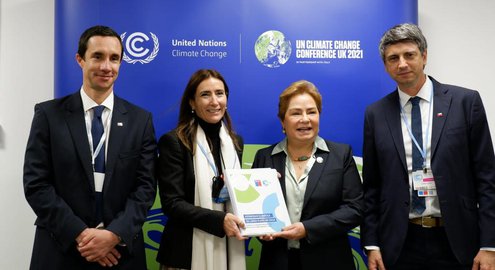PVTIME – As part of the COP26 framework, held in Glasgow, Scotland, Chile’s Government officially presented the country’s Long-Term Climate Strategy (Estrategia Climática de Largo Plazo, ECLP) to the Executive Secretary of the United Nations Framework Convention on Climate Change, Patricia Espinosa. The roadmap establishes the specific sectorial goals and targets that will make Chile carbon neutral and climate resilient by 2050 at the latest, as demanded by science, in order to cope with the impacts of climate change.

The document was handed over this morning by Chile’s Environment Minister, Carolina Schmidt, accompanied by Energy and Mining Biminister Juan Carlos Jobet and Science Minister Andrés Couve.
Minister Schmidt said that “we have fulfilled our commitment to deliver our ECLP to the UN Framework Convention on Climate Change. The strategy establishes 407 transition and transformation goals for all of the country’s key sectors, with new goals being set each year, so that we can achieve our targets. We are the first country in South America to comply with the provisions of the Paris Agreement and deliver this roadmap.”
The UN Climate Change Executive Secretary, Patricia Espinosa, commented that it is “an important achievement that confirms the commitment of Chile’s Government and its people to truly sustainable development. The strategy presented today is consistent with the goals of the Paris Agreement and establishes sectorial carbon budgets based on the commitments made by Chile in its Nationally Determined Contributions.”
Biminister Jobet highlighted that “the Long-Term Climate Strategy considers the transformation of the energy sector as one of its fundamental pillars. We are closing down coal-fired power plants and developing renewable energies, which will allow us to use clean energies in different sectors of the economy, such as transport, industry and also in our homes.”
Minister Couve stressed that with this milestone the country fulfills “one of Chile’s commitments to the fight against climate change. The Science Ministry participated in the previous report, as well as the reports that relate to nature-based solutions and the Technology Transfer Strategy as one of the implementation mechanisms.”
Goals
To achieve carbon neutrality and be a climate-resilient country, the ECLP has set specific goals and actions that the country must undertake to solve these challenges, establishing priorities by sector and year of compliance. In total, there are 407 measures.
By 2025, for example, the ECLP aims to remove 65% of coal-fired energy generation from the national grid, to add between 10,000 and 15,000 hectares of protected urban wetlands, to establish mandatory recyclability ecolabelling and to provide management plans for 100% of the marine protected areas designated before 2020.
By 2030, the ECLP aims to generate 80% of Chile’s electricity through renewable sources, to increase the network of glacier stations by 50%, to implement zero-emission fleets in large-scale mining and to provide health services to 100% of the urban population.
By 2040, the ECLP aims for green hydrogen to make up 20% of the country’s fuel matrix, for 100% of buses, taxis and shared-taxis to be zero-emission and to reduce the waste discharged into seas and beaches by 40%.
By 2050, the ECLP aims for Chile’s energy matrix to be 100% zero-emissions, to reduce industry and mining emissions by 70% and to develop Recuperation, Conservation and Management Plans for 30-50% of the country’s endangered species.











